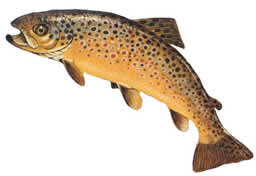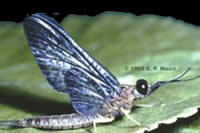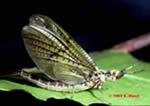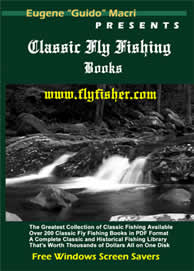Introduction to Fly Hatches
by
Eugene Macri
Aquatic and Environmental Scientist
In this introduction let's start off by talking about all the things
you'll find at the bottom of the stream. Perhaps we should describe the bottom of the stream:
-
All of the rocks, many of the plants (macrophytes and algae), debris,
wood, gravel, sand etc. are referred to as substrate.
So aquatic invertebrates live on or around the substrates of a stream or river.
-
Invertebrates are animals without backbones. Invertebrates that
have 6 legs are referred to as insects. There are other things in this invertebrate community such a
freshwater shrimp, scuds, cressbugs, crayfish and worms that do not have 6 legs and therefore are
classified as something else.
Classification Systems
Now why do scientists (mainly biologists) classify things?
Simply put: it makes things easier to study. Nature doesn't classify things but man does. Another thing you
should know that we will get into much later is that classification is an arbitrary science and not all
biologists will agree with classification, taxonomy and nomenclature (the naming of the insects). Here's one
of the more popular classification systems used by biologists today:
* (Domain)
o Archaea
o Bacteria (also called Eubacteria)
o Eucarya
* Kingdom
o Animalia
o Plantae
o Protista
o Monera or Procaryotae
o Fungi
* Phylum
* Class
* Order
* Family
* Genus
* Species
It should be noted that the above classification system is not
accepted
by all biologists. In the above system The Domain Eucarya refers to organisms
with true nuclear cell structure. As you can see the kingdom Animalia is under this and this is where the
insects and stream invertebrates reside. Most of the invertebrates on the stream bottom belong to the
Phylum Arthropoda (which means jointed appendages). As you go down the tree the categories get more specific
and thus you eliminate organisms till you get to the individual species. There are many subdivisions to
the above categories but we don't need to go there because if you just recognized how this works, it's more than
enough to understand the beginnings of aquatic entomology.
Every organism has a name, a scientific name
that is. The name is in Latin or Latinized as some might say. It usually consists of two parts, Genus and Species,
called binomial. This distinguishes it from the common names which are often local and confusing.
Sometimes the name can be made up of three parts and then it is a trinomial. Sometimes the scientist who
named it or someone who first discovered it will give it his or her own name of someone else's. For example,
one of the mayflies known as Blue Winged Olive has a scientific name of Baetis tricaudatus Dodds. In
this case Baetis is the Genus; tricaudatus is the species and the Dodds is the
name of a biologist associated with it. In most cased the Genus is capitalized and species is not. They
are either italicized or underlined.
Here are some examples of some flies that fly fishermen use with
their common and scientific names:
-
Sulfurs, Early Morning Sulfurs, Blue Winged Dun Orange Sulfur, Early
Season Sulfur, Late Season Sulfur Pale Morning Dun. Pale Eveining Dun: Ephemerella invaria,
Drunella lata etc.
Seems confusing isn't it. That's why scientists and some fly anglers refer to the Latin names
because the common names vary so much by location and their is no standardization. So the Latin names are nothing
more than a "standard" that all scientists can use no matter what language they speak. So if someone tells me it's
a sulfur... but then says it's an Ephemerella etc.....I now know what he's talking about. Latin is a
dead language because it doesn't change and isn't influenced by the time, fads, or culture and thus serves
scientists very well as the standard way to describe an organism that will be universally accepted no matter what
language the scientist speaks. Here's an example of the identification of the brown trout.

| Common Name |
Brown Trout |
Brown Trout |
| Scientific Name |
Salmo trutta |
Salmo trutta fario |
So why does the brown trout have two scientific names. Well because in some texts the brown trout
is often given the name Salmo trutta fario, the brown trout of small streams.
This a trinomial or 3 part name. Is this a distinct subspecies....ok now I got you because you want to know
what a subspecies is? So that's my point. Just understand the basics and don't worry about stuff like this; wait
till you get a better understanding of the entire system then you can go deeper into how things are classified.
Life Cycle of Aquatic
Insects
Aquatic insects are like terrestrial insect in that they undergo a life
cycle. Remember insects are Arthropods and must shed their exoskeleton to grow in a
process known as molting (humans have an endoskeleton and grow around it). Each mayfly, stonefly, caddisfly
etc. has it's own individual life cycle of molting depending upon environmental conditions. The changes of
the life cycle are known as metamorphosis. In America we differentiate two types of metamorphosis: Complete
and Incomplete. Examples of this are shown below:


The stages in a complete metamorphosis are egg, larva, pupa, and adult. In incomplete
metamorphosis the stages are egg, nymph, adult. Examples of insects with complete metamorphosis are
caddisflies, and butterflies. Examples of insects with incomplete metamorphosis are mayflies, and
dragonflies. In most European and Asia texts however, and for the most part in the world of entomology all
immature stages are referred to as larvae (larva is singular). This is a common mistake many American fly
fisherman make when they read descriptions from other countries since they refer to mayfly and dragonfly nymphs
simply as larvae. Insects actually "hatch" out of eggs. Matching the hatch should actually be referred to as
Matching the Emergence since aquatic insects emerge as adults.
This completes your introduction to Aquatic Entomology so let's summarize what we've learned:
Summary: Aquatic insects are invertebrates that undergo a life cycle of
metamorphosis in which they change from egg to adult. Most aquatic insects live on, or in the bottom material
of a stream or substrate. Scientists classify organisms to make them easier to study and understand. The
classification system of Taxonomy is an arbitrary standard agreed upon by most biologists. They have
assigned every living organism a scientific name which is written in Latin. This name consisting of Genus and
a Species is often called binomial nomenclature.
This completes Part 1. We Are Interested in What You Think! So drop us a line in the form
below!
| 






